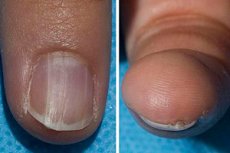
美国国立卫生研究院 (NIH) 的科学家发现,患有良性指甲异常可能会导致一种罕见遗传性疾病的诊断,这种疾病会增加患皮肤、眼睛、肾脏和胸部和腹部内壁组织(如间皮)癌症的风险。
这种疾病被称为 BAP1 肿瘤易感综合征,是由 BAP1 基因突变引起的,该基因通常发挥肿瘤抑制因子等功能。
该研究结果发表在《JAMA Dermatology》杂志上,并在 5 月 15 日至 18 日在达拉斯举行的研究皮肤病学会年会 (SID 2024) 上发表。
研究人员在对美国国立卫生研究院临床中心参与BAP1基因变异筛查研究的参与者进行研究时偶然发现了这一结果。作为研究的一部分,参与者入组时以及2岁及以上人群每年都会接受皮肤病学筛查。本研究纳入了来自35个家庭的47名BAP1肿瘤易感综合征患者。
“在基线基因评估中,当被问及指甲健康状况时,患者表示他注意到了指甲的细微变化,”该研究的共同作者、美国国立卫生研究院国家癌症研究所 (NCI) 遗传咨询师亚历山德拉·莱本森 (Alexandra Lebenson, MS) 说道。“他的评论促使我们系统地评估其他参与者的指甲变化,并发现了这一新的观察结果。”
对几位受试者的指甲及甲床进行活检,证实了研究人员对一种名为甲乳头瘤的良性肿瘤样异常的怀疑。这种疾病会导致指甲出现一条有色带(通常为白色或红色),沿着指甲长度方向,变色区域下方的指甲变厚,指甲末端也变厚。通常只影响一侧指甲。
然而,在30岁或以上患有已知BAP1肿瘤易感综合征的研究参与者中,88%的人患有累及多个指甲的甲乳头状瘤。研究人员认为,对于有个人或家族黑色素瘤或其他潜在BAP1相关恶性肿瘤病史的患者,指甲筛查可能尤其有价值。
美国国立卫生研究院国家关节炎和肌肉骨骼及皮肤疾病研究所 (NIAMS) 皮肤病学咨询服务主任、医学博士 Edward Cowan 表示:“这种观察在一般人群中很少见,我们认为,如果多个指甲出现与甲乳头状瘤相符的改变,应该怀疑患有 BAP1 肿瘤易感综合征。”
“这一发现是跨学科团队和自然史研究如何揭示罕见疾病新知识的绝佳例子,”该研究的共同作者、这些患者参与的临床方案的首席研究员、医学博士 Raffit Hassan 说道。

